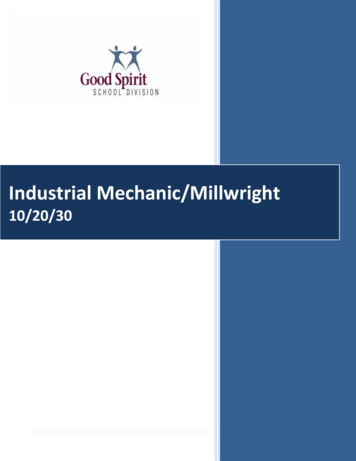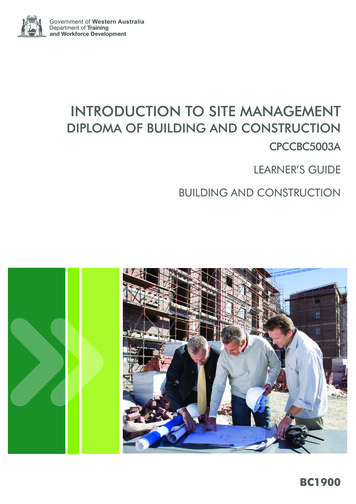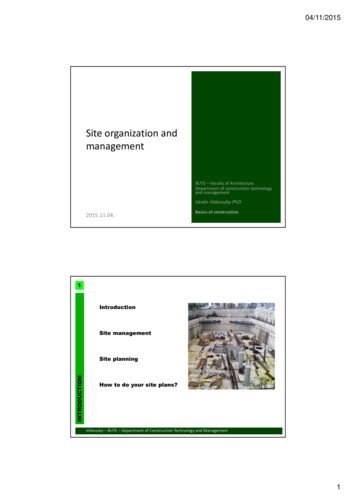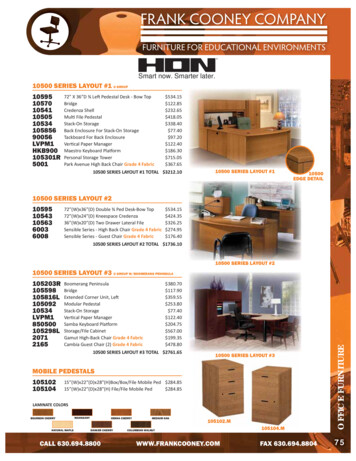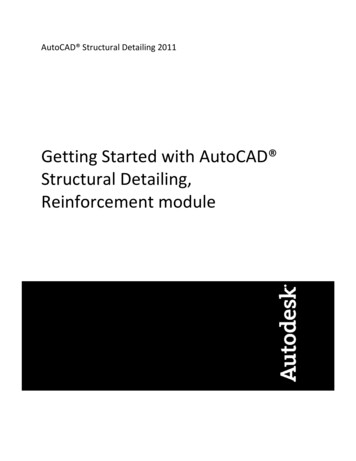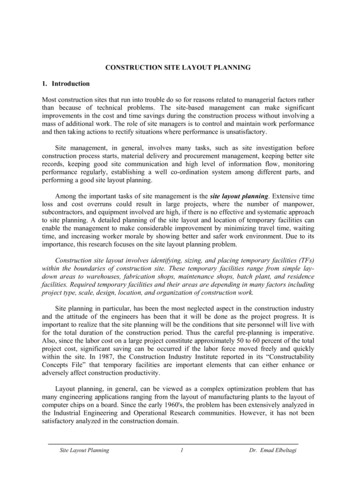
Transcription
CONSTRUCTION SITE LAYOUT PLANNING1. IntroductionMost construction sites that run into trouble do so for reasons related to managerial factors ratherthan because of technical problems. The site-based management can make significantimprovements in the cost and time savings during the construction process without involving amass of additional work. The role of site managers is to control and maintain work performanceand then taking actions to rectify situations where performance is unsatisfactory.Site management, in general, involves many tasks, such as site investigation beforeconstruction process starts, material delivery and procurement management, keeping better siterecords, keeping good site communication and high level of information flow, monitoringperformance regularly, establishing a well co-ordination system among different parts, andperforming a good site layout planning.Among the important tasks of site management is the site layout planning. Extensive timeloss and cost overruns could result in large projects, where the number of manpower,subcontractors, and equipment involved are high, if there is no effective and systematic approachto site planning. A detailed planning of the site layout and location of temporary facilities canenable the management to make considerable improvement by minimizing travel time, waitingtime, and increasing worker morale by showing better and safer work environment. Due to itsimportance, this research focuses on the site layout planning problem.Construction site layout involves identifying, sizing, and placing temporary facilities (TFs)within the boundaries of construction site. These temporary facilities range from simple laydown areas to warehouses, fabrication shops, maintenance shops, batch plant, and residencefacilities. Required temporary facilities and their areas are depending in many factors includingproject type, scale, design, location, and organization of construction work.Site planning in particular, has been the most neglected aspect in the construction industryand the attitude of the engineers has been that it will be done as the project progress. It isimportant to realize that the site planning will be the conditions that site personnel will live withfor the total duration of the construction period. Thus the careful pre-planning is imperative.Also, since the labor cost on a large project constitute approximately 50 to 60 percent of the totalproject cost, significant saving can be occurred if the labor force moved freely and quicklywithin the site. In 1987, the Construction Industry Institute reported in its “ConstructabilityConcepts File” that temporary facilities are important elements that can either enhance oradversely affect construction productivity.Layout planning, in general, can be viewed as a complex optimization problem that hasmany engineering applications ranging from the layout of manufacturing plants to the layout ofcomputer chips on a board. Since the early 1960's, the problem has been extensively analyzed inthe Industrial Engineering and Operational Research communities. However, it has not beensatisfactory analyzed in the construction domain.Site Layout Planning1Dr. Emad Elbeltagi
There are two general objectives which planners should seek to meet through carefulorganization of the site for construction. First, the site must be designed to maximize efficiencyof operations in order to promote worker productivity, to shorten project time and to reduce cost.Second, the final plan must create a project with a good work environment in order to attract andretain the best personnel and thus contribute to better work quality and productivity.The problem of site layout planning has been solved by researchers using two distinctlytechniques: optimization and heuristics. Mathematical optimization procedures have beendesigned to produce the optimum solutions. The heuristic methods, on the other hand, used toproduce good but not optimal solutions. However, the first category can not be adopted for largeprojects, and the second category is the only available mean for solving the complex real lifeprojects.2. The ProblemFailure to plan the site layout in advance is a prime cause of operational inefficiency, and canincrease the overall cost of a project substantially. In the absence of a precise site layout plan, thefollowing problems may occur:a. Material stacks wrongly located. Materials arriving on site are off-loaded into whatsomeone guesses to be the correct location. This problem may involve double or triplehandling of materials to another location. For example:- They may stocked over a drainage line or near the edge of excavation;- They are too far from the work area;- They are too remote from the hoist or not within the radius of the crane;- They impede the smooth flow of work traffic across the site;- Their delivery was wrongly phased and they are not needed until much later in theproject;- They are fragile.b. Plant and equipment wrongly located. For example:- The mixer is inaccessible for the delivery of materials; not enough room for thestorage of aggregates;- Fixed cranes are unable to reach all parts of the works;- Hoists have insufficient capacity or height to handle the loads or badly located inrelation to the floor layout;c. Inadequate space allowed. Where inadequate space is allowed for the stacking of materialsor activities:- Materials may be stacked to high or stacked on roadways causing hazards.- Working areas may become too cramped or additional areas may have o be allocatedwith the consequent waste of time caused by having to travel between them.d. Site huts wrongly located in relation to their effective use, such as:- Site office located too near noisy activities such as mixer, or located too near to siteroads in dusty conditions, or too remote with insufficient overview of the site.Site Layout Planning2Dr. Emad Elbeltagi
- Warehouses having inadequate access for loading and unloading or located ininsecure area.Therefore, before moving on to a site, it is necessary to prepare a detailed site plan,showing the positions to be taken by every item of equipment, accommodation, ancillary workareas and materials storage areas.3. Present PracticeIn construction, field practitioners manually mark up a single site drawing to include majortemporary facilities needed on site throughout the duration of the project. They depend onknowledge of years of experience, common sense, and adoption of past layouts in determiningpositions of temporary facilities on site. But, they can not keep track of all factors that couldaffect the selection, location, and interactions of all facilities to be positioned.In fact, site layout planning is one of the preplanning tasks to be accomplished in aconstruction project. This task has an interactive relationship with the other planning tasks suchas scheduling, selection of construction method, procurement and material planning, manpowerand equipment planning, and financial planning. So, it becomes a task as important as other tasksthat project managers have to accomplish.4. Site Layout Planning ElementsA well planned site including all temporary facilities and utilities lead to: 1) increasingproductivity and safety, 2) reducing area(s) needed for temporary construction, and 3)maximizing utilization. The following points should be considered in good site layout.1. Safety- Fire prevention: Fire is a major cause of damage on construction sites. So that, fireextinguishers are basic requirements on a construction project.- Medical services: On construction project a first aid kit is a must. In remote projects awell-equipped medical room with a doctor and nurse is important.- Construction safety clothing: Basic safety supplies like safety shoes, hard hats, gloves, andgoggles must be used by workers.2. Site AccessibilityEasy accessibility will keep the morale of the equipment and vehicle drivers high, minimizethe chance of accidents, and save time in maneuvering to arrive at and leave the project. Incase of large projects, proper planning is required to layout the roads leading from the nearesthighway. Internal roads are necessary for easy flow of work. Also, Parking Lots are providedfor the owner, office, and craft personnel, but this facility must be planned where space doesexist.Site Layout Planning3Dr. Emad Elbeltagi
3. Information Signs- Site map: It should locate details of the project, and displayed in the office of the sitesuperintendent or project manager and posted at the entrance gate.- Traffic regulatory signs: For large projects, traffic regulatory signs help in guiding thetraffic on the site and avoid accidents to a considerable extent.- Display of labor relations’ policy and safety rules: This will help in eliminating disputesbetween labor and management.- Emergency routes and underground services: It is important to display the emergencyescape routes on every floor as the building progresses. Locations of underground servicesshould be marked to prevent its damage.4. Security- Entrance: It is necessary to have a proper guard entrance to the site provided by a booth.Also, it is necessary to keep track of all visitors to the project.- Lighting: It is necessary to have a standby generator to maintain site lighting.- Fencing: The boundary should be fenced off from a security point of view.5. AccommodationOn large construction projects, it is necessary to provide camp accommodation for all type ofstaff involved in the project.6. OfficesThe offices should be close together, close to the site, and in a safe area. Also, provide theoffices with proper office equipment. The offices at the site may include job office, generalcontractor office, and sub-contractors and consultants Offices.7. Water Supply and SanitationIt is necessary to have water and toilet facilities in convenient locations to accommodate thework force.8. Material HandlingOne third or more of all construction operations can be classified as material handling. Theuse of proper equipment for material handling and advance planning for minimizing multiplehandling will result in direct cost and time savings.9. Storage and site cleaningIt is necessary to plan and reserve storage areas for materials so that multiple movement ofmaterial is avoided.Site Layout Planning4Dr. Emad Elbeltagi
- Laydown areas: Areas reserved for storage of large materials and equipment and it can beshort-term or long-term.- Warehouses: They are sheltered storage facilities where materials are stored until they havedisbursed to the job.- Material staging areas: They used when materials are stored near the work on a short-termbasis. They are generally as close to work as possible.- Site cleaning: It is necessary at a work place and especially where the extent of debrisproduced is high. Regular disposal of debris is necessary.10. Craft Change-HousesCraft change-houses provide sheltered space for craft personnel to change and store clothes,wash, and rest during waiting periods.11. Batch plant and Fabrication ShopsBatch plants are provided on projects where it is more economical to produce concrete on sitethan to buy a ready mix. Aggregate storage piles, cement silos and admixture tanks willaccompany an on-site batch plant. Shops are used where materials and equipment arefabricated on site. This includes electrical, mechanical, carpentry, and paint shops. Also,testing shops used to house the necessary testing equipment and personnel for the project.5. Temporary Facilities CharacteristicsIt is important to understand the characteristics of the temporary facilities before planning thesite layout. Six generic temporary facility characteristics are discussed in this section.1. Satisfying environmental and safety regulations: All temporary facilities should satisfyenvironmental and safety regulations. Special attention should be paid to temporaryfacilities like batch plants, which have high pollution potential. Planners have to makeproper arrangements to control the air, water, and noise pollution from such facilities.2. Availability of diverse solutions for the same problem: There are many arrangements thatcan be made to establish a temporary facility. For example, if a warehouse is required, theplanner can build a warehouse on the site, use existing facilities on the site, rent a buildingnear the site, or plan a just in time delivery. Based on the usage of the warehouses, eachalternative can be further divided into several sub items. For example, the material ofbuilding the facility can vary from wood, bricks, to a steel structure.3. Relatively short life span of a specific location: The life span of temporary facility dependson the duration of the project. In general, it must be removed as soon as the project iscompleted.4. Reutilization with a minimum loss for the same or modified function at another location:Due to the shorter life span of temporary facility on site, planners consider reutilization ofthe temporary facilities. This can result in saving the cost of construction. With appropriateSite Layout Planning5Dr. Emad Elbeltagi
modifications, most of the temporary facilities can be used for more different purposes.Therefore, good maintenance, and storage of the building materials can increase thefrequency of reutilization and decrease construction costs significantly.5. Easy of assembly, dismantling, and exploitation: temporary facilities structures which areeasy to assemble and dismantle will reduce both assembly and disassembly time. Asmentioned above, temporary facilities will need to be removed in a very short period oftime after project completion. Thus, temporary facilities structures should be easy toassemble and dismantle without any damage to the structure components. Prefabricatedmodules are ideal for constructing temporary facilities and they are usually easy toassemble and dismantle.6. Standardization of design: Standardization of design and construction of temporaryfacilities can increase the frequency of reutilization and reduce the work-hours and costrequired for construction the facilities. This approach makes the maintenance,transportation and storage of temporary facilities easy. The benefits of the learning curvecan be gained from repetitive field operations, which results in increase of productivity andquality. Also, benefits are obtained by providing grater interchangeability of spare partsand reducing the variety of spare parts stored in the warehouse.6. Facility Identification and SizingIdentifying the required temporary facilities for a specific project and determining their areas aredifficult decisions that require thorough consideration of the project conditions and localregulations. In current practice, layout planning is often done in a speedy manner by adjustingprevious plans based mainly on the project manager's experience and common sense. In manysituations, some facilities, which are required by local by-laws, such as a site first-aid office or afire route may be omitted. Accommodating these facilities later can be costly and can cause lossof site productivity. While some information related to facility identification and sizing havebeen documented in the literature, this information however is scattered and is not readily usable.In order to develop the knowledge base for the facility identification and area determination, theknowledge were acquired and compiled from different sources, including construction safety andhealth manuals, company handbooks, published dissertations, technical articles, and interviewswith some experts in the construction industry.Temporary Facilities SelectionOne of the characteristics of temporary facilities is the availability of diverse solutions for thesame function. This section describes some of the considerations when selecting the requiredtemporary facilities for a specific project.- Construction type: The construction of an industrial plant, such as power plant, requiresmore storage and fabrication area for process mechanical and electrical work than otherprojects such as a highway project.Site Layout Planning6Dr. Emad Elbeltagi
- Type of contract: For turn-key contract, the contractor can consolidate the administrativeand construction operations, means that fewer but larger and more efficient temporaryfacilities can be selected. On the other hand, if the project is managed under a series ofdifferent contracts, this will translate into a higher number of smaller temporary facilitiesserving each individual contractor.- Project size: A relatively small project can be managed from a trailer or portable structure.While a five to ten year project may need temporary facilities of a more permanent nature.- Project location: Projects located in uninhabited regions or in places where skilled labor isscarce require additional facilities for eating and living. Project far from industrial centersrequire more on site services such as batch plant, equipment maintenance shops, long termstorage area, and even some other recreational centers for the families.Also, the selection of some of the temporary facilities depends on the manpower permanentresident from the site. The work force breaked down into three categories as shown in Figure 1:L3L2L1Site5 km60 kmFigure 1: Work-force break-downL1:L2:L3:local labor force (5 km from site). No lodging or transportation needs.nearby labor force (5 - 60 km from site). No lodging needs, but dailytransportation needed.far away (more than 60 km from site). Lodging facilities needed.The type and number of temporary facilities needed for a specific project must bedetermined prior to their sizing and location. Table 1 gives a list of common temporary facilitiesthat can be used in a project. While some temporary facilities are to be selected from this list fora specific project, taking into account the factors cited above, as well as other temporaryfacilities justified by the uniqueness of the project.Site Layout Planning7Dr. Emad Elbeltagi
Table 1: A List of temporary facilitiesFacility 29303132333435363738Facility NameJob officeOwner representatives officeSubcontractors officeFirst aid officeInformation and guard houseToilet on siteStaff/Engineer dormitoryStaff/Engineer family dormitoryLabor dormitoryLabor family dormitoryDinning room for laborBathroom for laborRestroom for laborEquipment maintenance shopParking lot for mechanicsPrefabricated rebar storage yardRebar fabrication yardFabricated rebar storage yardCarpentry shopStorage yard for lumberStorage yard for formed lumberCement warehouseBatch-plant and aggregate storageCraft change-houseSampling / Testing labPipe jointing yardPipe storage yardWelding shopParking lotTankLong term laydown storageMachine roomElectrical shopSteel fabrication shopSandblast shopPainting shopScaffold storage yardMaterial warehouseTemporary Facilities SizingAfter selecting the temporary facilities that are needed on the site, the size required for themmust be estimated. The size of temporary facilities is mainly based on the manpowerrequirements, estimated quantity of work, production rate of resources, availability of site space,and cost considerations. Some of the rules of thumb, safety regulations, and other criteria forsizing temporary facilities are described below.Site Layout Planning8Dr. Emad Elbeltagi
Rules of thumb of sizing temporary facilitiesAccording to survey among 36 construction Company of various sizes, the size of temporaryfacilities are based on manpower requirements, project size, duration or costs. Ignoring the largevariations of the numeric values, his rules show that the companies have similar practices.However, some adjustments have to be made when they are applied to a unique project. Tables2, 3, and 4 illustrate the results of the survey. The values presented in Table 4 for projects rangesfrom 200 million to 4.5 billion, with average values around 2 billion.Table 2: Area estimates for temporary facilitiesMinimum (m2)Temporary Facility- Craft change house per worker- Time office per office worker- Number of people per brass alley(with average area per person)- Number of workers per parking space- Area required for each unit parking0.095.4100 Person122.5Average (m2)1.028.7175 Person0.371.730Maximum (m2)2.713.5250 person436Table 3 Range of office space requirementsSize Range (m2)Office12 – 259 – 149 – 1146 – 8428 – 9337 – 8017 – 1928 – 7411- Project Manager- Construction Manager- Mechanical/ Electrical/ Civil Engineer per Engineer- Purchasing (total)- Schedule & Cost Control (total)- Accounting (total)- First Aid & Safety per Office- Clerical (total)- EstimatorThe size of sanitary facilities depended on the manpower requirements and it can be entirelytemporary or permanent. If portable toilets are used, a minimum of one toilet per twenty personsmust be provided. Space required for some facilities as fabrication shops dependent on theamount of on-site fabrication work as well as rate of fabrication dictated by constructionschedule. Also, the size of the equipment maintenance shop depends on the amount ofconstruction equipment on the site.Table 4: Temporary facilities areas based on project costArea (m2 / Million)FacilityWarehouseLaydown AreasFabrication ShopEquipment ShopAdministration officeSite Layout Planning2.8028.90.380.371.119Dr. Emad Elbeltagi
Based on experience, the following general equation is used to determine the materialstorage area for any type of construction project. Table 5 shows the parameters that affect thisequation. The total required storage area, An, is calculated as follows:An ( Q max / I m ) / q nWhere:(1)Qmax qdaily * t * k, qdaily Qtotal / TQmaxImqnQtotalqdailyTtk: Maximum estimated quantity in storage space;: Utilization index for materials;: quantity of materials can be stored per m2;: Total quantity of materials required for the project;: estimated quantity required per day;: construction period (not total project duration);: Average stock (days); and: Fluctuation factorTable 5: Parameters for sizing material storage areaDescriptionCementAggregate forConcreteBricksConcrete blocksLumberReinforcingbarsConcrete pipesIron pipesFuelDelivery &Average StockqnUnitquantity / m2Storage methodt (days)ImUtilization factorWaste%BagsBulktonton30301.5 - 1.8---------0.5 - 3603030451.5 - 2.0700-100075 - 1001.7 - 2.60.6 - 0.70.7 - 0.80.7 - 0.80.6 - on753075301.3 -1.50.8 - 1.10.6 - 1.50.5 - 0.70.75 - 0.80.6 - 0.70.6 - 0.70.7 - 0.81-1.21.00.51.0Table 6 shows the rules of thumb developed by Obayashi Corporation of Japan. The areasgiven in Table 6 are based on the following assumptions:- For each facility, the unit area includes areas for corridors, closets and aisles.- The area of the bathroom should be adequate for simultaneous use by 10% of theresidents, and one toilet for 15 labors.- The number of labors is the peak number of labors required.Site Layout Planning10Dr. Emad Elbeltagi
Table 6: Equations to calculate temporary facilities sizeEquations for CalculationsDescription1. Job office2. Dormitory for Staff / Eng.3. Dormitory for Staff / Eng. Family4. Dormitory for labor5. Dormitory for labor family6. Bathroom for Staff / Eng.7. Bathroom for staff / Eng. Family8. Toilet (job office)9. Toilet (staff / Eng. Dormitory)10. Dining room for labor11. Bathroom for labor12. Toilet for labor Dormitory13. Parking lot14. Canteen15. Owner's representative office16. Toilet on site17. Rest area for labor18. Equipment maintenance shop19. Parking lot for mechanician20. Material warehouse21. Rebar fabrication yard22. Rebar storage yard (prefab.)23. Rebar storage yard (straight)24. Carpentry shop25. Form storage yard26. Cement warehouse27. Explosive warehouse28. Detonator warehouse29. Explosive treatment shop30. subcontractor office31. Information office32. Test laboratory33. First aid34. machine room35. Site area*m: million**sf: square feetVariablepeak number of Staff/Eng.variable 1 - variable 3number of Staff/Eng. With familypeak number of laborspeak number of labors with familyvariable 2 x Use Ratevariable 3variable 1 x Use Ratevariable 2 x Use Ratevariable 4 x Use Rate - variable 5variable 4 x Use Ratevariable 4 x Use Ratenumber of carsvariable 1 x (1 – Use Rate)the number of representativesvariables (14 15 17) / 15variable 4number of mechaniciansnumber of mechaniciansproject costpeak number of iron workers(peak number of usage/day)x days(peak number of usage/day)x dayspeak number of carpenters(peak number of usage/day)x days(peak number of usage/day)x daysmaximum storage 3t5t10tmaximum storage 3t5t10tArea needed for the machinesBuilding areaUnitUse Rate%80.73 sf**/pp86.11 sf/pp322.92 sf/pp48.44 sf/pp***269.1 sf/pp43.06 sf/pp21.53 sf/pp32.29 sf/pp32.29 sf/pp21.53 sf/pp32.29 sf/pp26.91 sf/pp215.28 sf/car64.58 sf/pp86.11 sf/pp32.29 sf/toilet16.15 sf/pp322.92 sf/pp322.92 sf/pp150-266 sf/m*75.35 sf/pp16.15 sf/ton10.76 sf/ton53.82 sf/pp0.72 sf0.36 sf/pack80.73 0sf107.64 sf161.46 sf37.670 sf53.820 sf80.730 sf32.29-64.58 sf269 - 398.3 sf484.4-645.8 sf319.2-538.2 sf215.3-322.9 sf4 - 5 times2 - 4 times7080752010106010108030-***pp: per person7. Regulations and Safety StandardsSome safety rules were also compiled from safety and health manual (ILO 1992), safety andhealth administration (OSHA 1987), building codes (UBC 1985; SBC 1985). Some of theseregulations are listed below.Site Layout Planning11Dr. Emad Elbeltagi
- At least 10 feet clearance from buildings or structures shall be maintained for piles oflumber and other combustible materials to be used in the construction.- Driveways between and around open yard combustible storage piles shall be at least 15feet wide and free from accumulation of rubbish.- Material stored inside buildings under construction shall not be placed within 6 feet of anyhoist way or inside floor openings, or within 10 feet of an exterior wall, which does notextend above the top of the material stored.8. Examples of Site Layout PlanningExample 1Figure 2 illustrates the layout of building materials and access roads for the purposes of servicingtwo hoists for the erection of a low-rise building. Comment on and criticize the present layout inrelation to the positioning of both the materials and hoists.scaffoldwaste affold storebuildingconcretebatch planthoistsstoresmat. stockpilemortermixercement silotemporary eck pointFigure 2: Existing site layoutCriticism of existing site layout:- Both hoists have separate scaffold staging, causing increased costs.- Materials are not stockpiled near hoists.- Entrance to the site is too narrow for truck to pass.Site Layout Planning12Dr. Emad Elbeltagi
- Stores are located behind the batching plant so obscuring storeman's view andcheck point is separated from the stores.- Concrete and mortar mixers are located too far from the hoists.- Stockpiles are dispersed and hinder unloading.- Temporary roads are long and narrow.- Some stores are difficult to reach.waste dstockpilehoistsconcrete ary roadlaboratory morter mixercheck pointFigure 3: Improved site layoutSuggested improved layout:-Both hoists are housed in a common scaffold.Batching plants have direct discharge into dumpers.The access has been widened near the site entrance.The stores are located to give a good view of all materials stockpiles, and aresited near the temporary road.- Concrete and mortar mixers are located near the hoists.- The temporary road is shorter and wider.- A compound is provided to police non-bulk materials.Site Layout Planning13Dr. Emad Elbeltagi
Example 2Figure 4 shows the construction site for the construction of a radio transmitter station on aremote site in open location. The site involves the construction of a transmitting tower andtransmitter building along with some access roads.transmitter buildinggeneratorhousesewerlineR.C. pylonbaseserosionsite tobe filledcentre line ofproposedstation accessroadseptictankFigure 4: Transmitter station construction siteThe contractor prepared the site layout plan as shown in Figure 5. In developing this given plan,the contractor collected the following information to layout the site:- All equipment was delivered before building foundations were complete. Allother fitting also delivered (doors, sanitary, etc.).- Generator house completed. Hoist was not available at commencement and hasonly just delivered.- Nearest pure water is in the town 20-km away. Water delivered by tanker andstored in 6 200-litre drums.- Pylon bases and sewer/septic tank not yet started.- Agents' office is sited on a privileged place and to satisfy the best view for site.Criticize the layout given in Figure 5 and prepare another layout to correct the criticism.Site Layout Planning14Dr. Emad Elbeltagi
sitestores officeTo er buildingmason'syardramp to1st floorconcretemixerStack ofpylongirderserosionsiteto befilledR.C. pylon basesgener.housewatermortarmixerstockmakingand curingcentre line ofproposed stationaccess roadto majorhighwaySealed containers forgenerators, transmittercomponenetssteel laid atrandom ongroundCarpenters'shedofficesfabrication andstacking benchsanitary fittings and pipesmetal door andwindow framestimberstorageline ofsewerwatchman'shutseptictankWorkers' canteen andlatrines 200 m awaytemporaryaccess roadnearest town 20km distantFigure 5: Existing site layoutCriticism of existing site layout- In general, the working area is too spread out, making control more difficult andincreasing travelling time about the site which will lead to reducingproductivity.- Site latrines and canteen are too far away, causing loss of time due tounneces
many engineering applications ranging from the layout of manufacturing plants to the layout of computer chips on a board. Since the early 1960's, the problem has been extensively analyzed in the Industrial Engineering and Operational Research communities. However, it has n
